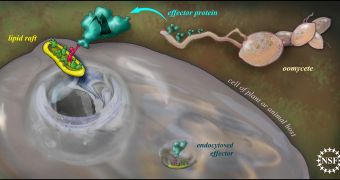Throughout history, microbes and other microorganisms left their mark on humanity, and not in a good way. Worthy of mention is the Irish potato blight of the 19th Century, which was triggered by a type of parasitic algae, and which killed more than a million people, reducing the country's population by between 20 and 25 percent. Researchers now believe that they may have identified the common mechanism that allows microorganisms to be so successful when infecting. The discovery is bound to trigger a new wave of investigations into means of preventing that from ever happening again.
The current Asian and African wheat rust epidemics are also caused by microbes using the same infection mechanisms as they did centuries ago. Experts know that fungi and oomycete (parasitic algae) can infect humans as well, thanks to the same, aforementioned mechanism. Direct consequences of fungi infestation include several types of conditions generally associated with AIDS, as well as valley fever. Rice farmers are among the most susceptible to these nefarious influences. Their feet, eyes and brains are commonly affected by such infections. Fish including salmon, living in the area, are also decimated by the pathogens.
“Our findings suggest broad new strategies for combating the most damaging diseases of the world's major food crops, including wheat, rice, maize and potatoes, as well as several nasty human diseases,” says Brett Tyler, the leader of the new investigation. He is based at the Virginia Polytechnic Institute (VPI) Bioinformatics Institute, in Blacksburg, Virginia. His work was funded jointly by the US National Science Foundation (NSF) and the US Department of Agriculture (USDA)'s National Institute of Food and Agriculture (NIFA). The research team determined that the microorganisms initiate the infection process by secreting a special protein, as soon as they make contact with a prospective host.
The study also reveals the mechanism of infection in exquisite detail. The team managed to evidence exactly how the proteins, lipids and cells involved interact with each other, determining the course of the infection. “This is a great example of transdisciplinary research, pulling together researchers from around the world with expertise in oomycetes, fungi, human disease and lipid chemistry,” explains the lead author of the work, VPI graduate student Shiv Kale. His work was funded by a predoctoral fellowship from the NSF.

 14 DAY TRIAL //
14 DAY TRIAL //